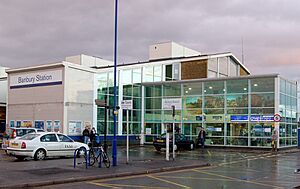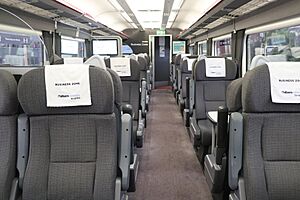Chiltern Railways facts for kids
| Info | |||
|---|---|---|---|
| Franchise(s): | Chiltern | ||
| Main region(s): | |||
| Other region(s): | |||
| Fleet size: |
|
||
| Stations called at: | 66 | ||
| Stations operated: | 32 | ||
| National Rail abbreviation: | CH | ||
| Parent company: | Arriva UK Trains | ||
|
|||
Chiltern Railways is a British company that runs trains. They have been operating the Chiltern Railways train service since July 1996. Since 2009, they have been part of Arriva UK Trains, which is a bigger transport company.
Chiltern Railways started as M40 Trains. It was created by former managers from British Rail, with help from John Laing and 3i. In June 1996, M40 Trains won the contract to run the Chiltern Railways service. They officially took over on July 21, 1996.
The company quickly began to add more tracks to the Chiltern Main Line. This project was called Evergreen. They also ordered new Class 168 Clubman trains to add to their existing fleet. In August 2000, Chiltern Railways won a 20-year contract. This led to Evergreen phase 2, which made trains go faster near Beaconsfield. They also built two new platforms at their main station in London, London Marylebone. In January 2010, a £250 million plan for Evergreen phase 3 was agreed. This plan updated the line to allow trains to travel at 100 miles per hour, making journeys much quicker.
In August 2002, the John Laing Group became the only owner of Chiltern Railways. Later, in January 2008, the company was sold to Deutsche Bahn, a German railway company. Chiltern Railways then became part of Arriva UK Trains in early 2011. Around this time, Chiltern was known as one of the best train operators in Britain. Their trains were on time more than 90% of the time. However, new timetables introduced in the 2010s often caused problems for passengers.
A major problem happened on June 30, 2005, when the Gerrards Cross Tunnel collapsed. This forced the main line to close for six weeks. Tesco, which was building a supermarket over the tunnel, paid money to Chiltern Railways and Network Rail for the disruption.
Chiltern Railways runs passenger services from London Marylebone. These trains go along the M40 area to places in Buckinghamshire, Oxfordshire, Northamptonshire, and Warwickshire. They also run longer journeys to the West Midlands. Trains on the Chiltern Main Line go from London to Birmingham Moor Street, Stratford-upon-Avon, and Oxford. Some trains during busy times go all the way to Stourbridge Junction.
Chiltern Railways also operates trains on the London–Aylesbury line to Aylesbury. Some of these continue to Aylesbury Vale Parkway. They also run trains on the Princes Risborough to Aylesbury and Oxford to Bicester branch lines. From December 2010, Chiltern started a Chiltern Mainline service. This service used a Class 67 locomotive pulling modern Mark 3 carriages and a Driving Van Trailer.
Contents
How Chiltern Railways Started
Chiltern Railways began with a group of managers from British Rail. They wanted to buy one of the train services that would be created when British Rail was privatised. In April 1995, they received a licence from the railway regulator.
The team realized they needed more money to make a successful bid. So, they got support from the investment group John Laing and the investment company 3i.
In October 1995, M40 Trains was formed. The railway managers owned 51% of the company. John Laing Group owned 26%, and 3i owned 23%. The company spent about £38 million on its bid for the Chiltern Railways service. In June 1996, M40 Trains was chosen to run the Chiltern Railways service for seven years. It was special because its directors owned more than half of the company.
On July 21, 1996, the company started running trains, taking over from British Rail. Chiltern Railways was the first train company after privatisation to order new trains. These were the Class 168 Clubman trains. However, these new trains had some problems at first because they were put into service very quickly. By April 1999, the company said it had 50% more staff and ran 25% more services than British Rail had. Also, the money the government gave them each year slowly decreased.
In early 1999, the ownership of M40 Trains changed. The John Laing Group bought more shares, increasing its ownership to 84%. The remaining 16% was owned by some of the former British Rail managers.
In March 2000, it was announced that M40 Trains and the British transport group Go-Ahead were the top choices for the next Chiltern contract. In August 2000, M40 Trains won the new contract, which would last for 20 years. This was on the condition that they made various improvements. The new contract period began on March 3, 2002.
In August 2002, John Laing bought the remaining 16% of shares in M40 Trains. In September 2006, John Laing was bought by the investment firm Henderson Equity Partners for £887 million.
In December 2004, Chiltern Railways started running passenger services on the Leamington Spa to Stratford-upon-Avon line. This service was previously run by First Great Western Link. In June 2006, Chiltern was asked to bid to operate the Snow Hill Lines. However, they did not win this bid.
Tunnel Collapse and Changes
In mid-2005, Chiltern Railways' services were greatly affected by the collapse of Gerrards Cross Tunnel. In 1996, the store Tesco wanted to build a supermarket near Gerrards Cross railway station. Even though the local council first said no, the plan was approved in July 1998. Because there wasn't enough space, Tesco started building a tunnel over the active railway line.
On June 30, 2005, the partially built tunnel collapsed. No one was hurt, but the line had to close completely for over six weeks. It reopened on August 20, 2005. Tesco paid about £200 million in compensation to Chiltern Railways and Network Rail for the disruption. Tesco also promised to pay for a campaign to get passengers back. The tunnel's construction started again in January 2009. The completed store opened in late November 2010.
In July 2007, Henderson Equity Partners announced they wanted to sell Laing Rail and the Chiltern Railways contract. Transport groups like Arriva and Go-Ahead were interested. By December 2007, only the German railway company Deutsche Bahn and the Dutch company NedRail were still bidding. In January 2008, Deutsche Bahn bought Laing Rail. This made Chiltern Railways part of the DB Regio group. In early 2011, the company was reorganized, and DB Regio became part of Arriva UK Trains.
In May 2011, Chiltern took over running services on the Oxford–Bicester line from First Great Western. On October 26, 2015, the company opened two new stations: Oxford Parkway and Bicester Village. These stations provided services between north Oxford and London Marylebone. In December 2016, Chiltern Railways started running trains from Oxford to London Marylebone.
In 2021, after the COVID-19 emergency, Chiltern received a new contract from the Department for Transport. This contract replaced their old agreement and will last until December 12, 2027.
Chiltern Railways was one of several train operators affected by the 2022–2024 United Kingdom railway strikes. These were the first national rail strikes in the UK in 30 years. Chiltern workers joined in these strikes because of disagreements over pay and working conditions.
On October 21, 2024, Chiltern Railways and Great Western Railway began testing trains on the first part of the East West Rail route. This route is between Oxford and Milton Keynes Central. The full service is expected to open in 2025. In March 2025, the Department for Transport confirmed that Chiltern Railways would operate passenger services between Oxford and Milton Keynes, starting later in 2025.
Train Services
Chiltern Railways runs regular services on five main routes.
The Chiltern Main Line is the most important route for Chiltern Railways. It connects the big cities of London (Marylebone station) and Birmingham (Moor Street station). It passes through towns like High Wycombe, Banbury, Royal Leamington Spa, Warwick, and Solihull. Chiltern Railways runs trains along the entire line, from local stopping trains to fast express trains. The quickest journey from Birmingham to London on this route takes 99 minutes. Other companies like CrossCountry and West Midlands Trains also use parts of this line.
The London–Aylesbury line is another important route. It connects London (Marylebone) with Aylesbury via Amersham. All Chiltern Railways trains on this route go the full distance between Marylebone and Aylesbury. Most trains continue one station further to Aylesbury Vale Parkway. This line shares tracks with London Underground's Metropolitan line for part of the journey. Beyond Amersham, only Chiltern Railways trains operate.
The other three routes are branch lines. The Aylesbury–Princes Risborough line connects Princes Risborough (on the Chiltern Main Line) with Aylesbury. Most trains on this line continue to London Marylebone, giving Aylesbury another way to reach central London. The Oxford–Bicester line connects Oxford with Bicester. This line is mostly used by express services to and from Marylebone. The Leamington–Stratford line connects to the Chiltern Main Line at Hatton and runs to Stratford-upon-Avon. This branch line is also used by West Midlands Trains.
Here is a simple look at the routes during off-peak times, Monday to Friday:
| Chiltern Main Line | ||
|---|---|---|
| Route | tph | Calling at |
| London Marylebone to Birmingham Moor Street | 1 |
|
| London Marylebone to Birmingham Snow Hill | 1⁄2 |
|
| London Marylebone to Banbury | 1⁄2 |
|
| Leamington Spa to Birmingham Moor Street | 1⁄2 |
|
| Oxford-Bicester line | ||
| Route | tph | Calling at |
| London Marylebone to Oxford | 1 |
|
| 1 |
|
|
| London–Aylesbury and Aylesbury–Princes Risborough lines | ||
| Route | tph | Calling at |
| London Marylebone to High Wycombe | 1 |
|
| Princes Risborough to Aylesbury | - |
|
| London Marylebone to Aylesbury | 1 |
|
| London Marylebone to Aylesbury Vale Parkway | 1 |
|
| Leamington–Stratford line | ||
| Leamington Spa to Stratford-upon-Avon | 1⁄2 |
|
Special Train Services
Chiltern Railways runs two special train services called "parliamentary trains". These services are run to keep the train drivers familiar with the route.
- Cherwell Valley line: One train runs daily on the Cherwell Valley line from Oxford to Banbury. This train runs just after midnight from Tuesday to Saturday. It stops at Tackley, Heyford, and Kings Sutton. There is no return train to Oxford. Regular services on this line are run by Great Western Railway and CrossCountry.
- New North Main line/Greenford branch line: Chiltern Railways used to run a weekday service to and from West Ealing in the late morning. This service was stopped during the COVID-19 pandemic and has since been replaced by a bus service.
Buckinghamshire Railway Centre Visits
On some Bank Holiday Mondays, trains used to go beyond Aylesbury to the Buckinghamshire Railway Heritage Centre at Quainton Road. This is a short distance north of Aylesbury Vale Parkway. However, these special services have not run since 2019. The tracks are still used by freight trains.
Tickets and Seating
Chiltern Railways offers "Route: High Wycombe" tickets for their route between Birmingham and London. These tickets are cheaper than "Route: Any Permitted" tickets, which can be used on faster services like Avanti West Coast to London Euston. Chiltern only offers standard class seating, unlike some other companies that have first class.
Until January 2022, Chiltern had a "Business Zone" carriage on their trains pulled by Class 68 locomotives. Passengers could pay extra to sit in larger, more comfortable seats. This upgrade used to include free drinks and snacks. However, since May 2017, free refreshments were stopped on all Chiltern Railways services.
From January 2022, the "Business Zone" is no longer offered. The former Business Zone carriage can now be used by any passenger with a valid ticket at no extra cost.
Train Performance
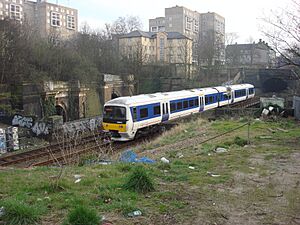
When Chiltern Railways first started, they received a lot of criticism. In 1998, their trains were often late or unreliable. This led to them having to pay fines and give refunds to passengers.
By the mid-2010s, Chiltern was considered one of the best train operators in Britain. Their trains were on time more than 90% of the time. However, after changes in November 2015 and some track problems, punctuality dropped to 86% in December 2015. Chiltern's on-time performance is measured strictly. They have a five-minute window for a train to be considered on time, while other long-distance companies have a ten-minute window.
A new timetable in September 2011, along with major track work, caused many complaints from customers. A petition was started to review the service. Another new timetable in December 2012 also caused frustration, especially for passengers using Saunderton and Princes Risborough stations.
Project Evergreen: Improving the Lines
Evergreen is the name Chiltern Railways gave to major projects to improve their train lines and services. These projects were planned over the 20-year period of their contract and were divided into three phases.
Evergreen 1: Adding More Tracks
The first phase focused on adding a second track to the Chiltern Main Line between Princes Risborough and Bicester North in 1998. More tracks were added between Bicester North and Aynho Junction in 2001. Several stations were also rebuilt. Haddenham and Thame Parkway was rebuilt with two platforms instead of one. A new platform was also added at Princes Risborough. Finally, the speed limit for trains was increased after improvements to the tracks.
Evergreen 2: Faster Speeds and New Platforms
Phase 2 began after Chiltern won its 20-year contract in August 2000. The biggest change was moving the train route through Beaconsfield. This allowed trains to go faster, up to 75 miles per hour. Other improvements included better signalling between High Wycombe and Bicester, and between Princes Risborough and Aylesbury. Two new platforms were built at London Marylebone, and a new train depot was built at Wembley.
Evergreen 3: Major Upgrades for Speed
In January 2010, the Department for Transport, Chiltern Railways, and Network Rail agreed to a £250 million upgrade for the Chiltern Main Line.
Phase 1: 100 mph Journeys
Phase 1 of this project is now complete. It involved upgrading the Marylebone – Birmingham Chiltern Main Line to allow trains to run at 100 miles per hour on an extra 50 miles of track. Train junctions at Neasden, Northolt, and Aynho were changed to allow higher speeds. A new track was added at Princes Risborough. A new turning track was built at Gerrards Cross. Also, a new, straighter track was built from Northolt Junction to Ruislip Gardens. The old speed limits through Bicester North were removed for 100 mph speeds. Two extra platforms at Birmingham Moor Street reopened in December 2010.
These speed increases greatly reduced journey times. For example, the fastest journey from Marylebone to Birmingham Moor Street is now 90 minutes, down from 117 minutes. The former chairman of Chiltern Railways, Adrian Shooter, said that this project was special because it did not need money from taxpayers.
Here's how much faster journeys became:
| Old time | New time | |
|---|---|---|
| Gerrards Cross | 21 | 18 |
| High Wycombe | 34 | 23 |
| Princes Risborough | 41 | 32 |
| Bicester | 56 | 44 |
| Banbury | 63 | 50 |
| Leamington Spa | 85 | 67 |
| Solihull | 107 | 84 |
| Birmingham (Moor Street) | 117 | 92 |
Phase 2: Connecting to Oxford
In October 2012, permission was given to start Phase 2 of the Evergreen 3 project. This phase focused on services between London Marylebone and Oxford. A new double track was built to connect the Oxford–Bicester line at Bicester Village to the Chiltern Main Line. This allowed a new train service from Oxford to London Marylebone.
A new station, Oxford Parkway, was built at Water Eaton. Services between Oxford Parkway and London started on October 26, 2015. The link from Oxford Parkway to Oxford main station became active on December 12, 2016. All signals on this route are controlled by the Marylebone Signalling Centre.
As part of Phase 2, the Oxford to Bicester Village service was transferred from First Great Western to Chiltern in May 2011. Part of the line between Wolvercote Tunnel and Bicester Village was made into a double track again. The project also included extra platforms at Oxford, Islip, and Bicester Village.
Network Rail provided the money for these upgrades. They will get this money back over the next 30 years. The main construction work was done by BAM Nuttall, with partners Jarvis and WS Atkins.
Future Plans for Chiltern Railways
Besides the completed Evergreen projects, other possible improvements for Chiltern's routes have been discussed. These include:
- Upgrading the Acton–Northolt line to new platforms at Old Oak Common. This upgrade would also extend to London Paddington to increase capacity on the Chiltern Main Line.
- Making the tracks faster at Beaconsfield to help achieve a 90-minute journey time between London and Birmingham.
- Remodeling Banbury Station and its tracks.
- Building the West Hampstead interchange to make it easier to change trains to other lines like the London Overground and Jubilee line.
- A new Chiltern Metro Service that would run more frequent trains for stations like Wembley Stadium and South Ruislip.
- Re-opening the passenger line between Oxford and Bedford as part of the East West Rail project. Also, a line from Aylesbury to East West Rail at Claydon LNE Junction to connect to Milton Keynes.
- Extending Oyster Pay-as-you-go to High Wycombe and Aylesbury. Contactless payment was extended to High Wycombe in June 2024.
East West Rail Service
In March 2025, Chiltern announced that they would operate passenger services on the East West Rail line. This service will run between Oxford and Milton Keynes Central. It will stop at Oxford Parkway, Bicester Village, Winslow (a new station), and Bletchley stations. Chiltern expects this service to start in late 2025.
Train Fleet: What Trains Chiltern Uses
Chiltern Railways started with 34 Class 165 Turbo diesel multiple units (DMUs) from British Rail. When they began in July 1996, they promised to bring in new trains. In December 2004, five more Class 165s were moved from First Great Western Link. Between 2003 and 2005, all 39 Class 165s were updated. They had air conditioning installed and a first-class seating area added. These trains are mostly used for services to Aylesbury and Banbury.
Chiltern ordered several groups of Class 168 Clubman DMUs. These trains started service between 1998 and 2004. Chiltern eventually operated nine three-car and ten four-car sets. These trains are used across the network.
In April 2003, Chiltern brought back a single Class 121 Bubble Car train to use on the Aylesbury to Princes Risborough route. A second Class 121 was added in May 2011. A third Class 121 was bought in March 2013 for spare parts. On May 19, 2017, the Chiltern Bubble cars ran for the last time because it was too hard to find spare parts for them.
In January 2008, Chiltern ordered four two-coach Class 172 Turbostars. These started service in June 2011. They cannot operate on London Underground lines unless they are attached to a Class 165 or Class 168 train. Although they were meant for local services, they often traveled as far as Birmingham. In mid-2021, all of Chiltern's Class 172s were leased to West Midlands Trains. In December 2021, it was announced that the Class 172/1 trains would not return to Chiltern.
From December 2010, Chiltern started running two special services during busy times. These services used a Class 67 diesel locomotive pulling Mark 3 coaches and a Driving Van Trailer. One set was rented from Wrexham & Shropshire for a Birmingham Moor Street to London Marylebone service. Another set used Mark 3 coaches owned by DB-Regio for a Banbury to London Marylebone service.
After Wrexham & Shropshire stopped operating in January 2011, Chiltern started using a second set of their trains from May 2011. For the new timetable in September 2011, these trains had a Mainline logo and blue stripes added. Class 67 locomotives continued to power these trains.
In 2012, the Mark 3 coaches were updated. They had new sliding doors and special tanks for toilets. More Mark 3 coaches were updated to create a fifth set and make existing sets longer.
Between 2015 and 2016, Class 170 Turbostars from First TransPennine Express moved to Chiltern Railways. Chiltern received five of these Class 170s in May 2015 and the remaining four in July 2016. These trains were changed to work with Chiltern's existing Class 168s and were renamed Class 168/3s.
In early 2014, Chiltern Railways agreed to use six Class 68 locomotives from Direct Rail Services (DRS). These trains replaced the Class 67s on the London Marylebone to Birmingham service.
In July 2021, Chiltern Railways changed one of its Class 168 units (168329) into a Battery Hybrid train, called "HybridFlex". In February 2022, it started running services between London and Aylesbury. Chiltern said the HybridFlex trains accelerate faster, use less fuel, and are quieter.
In August 2023, Chiltern Railways started looking for new trains.
In October 2024, the first of the newly updated Class 168 trains started carrying passengers. This £12 million update will continue for the whole fleet in 2025. It includes new paint, updated interiors, new Wi-Fi, USB charging points, and improved heating and cooling systems.
In March 2025, Chiltern Railways announced they would be the train operators for the East West Rail line between Oxford and Milton Keynes Central. This service will use Class 196 trains.
In August 2025, the company ordered new Mark 5A trains from Beacon Rail. This order also includes the Class 68 sets previously used by TransPennine Express. These new carriages will replace the older Mark 3 coaching stock.
Trains Chiltern Uses Now
| Family | Class | Image | Type | Top speed | Number | Carriages | Routes operated | Built | |
|---|---|---|---|---|---|---|---|---|---|
| mph | km/h | ||||||||
| Networker | 165/0 Networker Turbo | 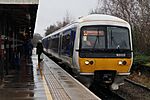 |
DMU | 75 | 120 | 28 | 2 | All Chiltern Railways services (apart from Mainline services) | 1990–1992 |
| 11 | 3 | ||||||||
| Bombardier Turbostar | 168 Clubman |  |
100 | 160 | 5 | 4 | Chiltern Mainline and some local services | 1998 | |
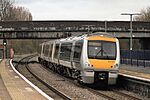 |
6 | 3 | 2000 | ||||||
| 2 | 4 | ||||||||
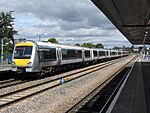 |
3 | 3 | 2004 | ||||||
| 4 | |||||||||
 |
9 | 2 | 2000 | ||||||
| Stadler UKLight | Class 68 | 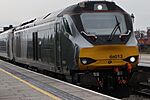 |
Diesel-electric locomotive | 8 | 6 | Chiltern Mainline services | 2014 | ||
| BREL | Mark 3 | 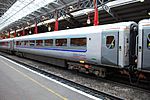 |
Passenger carriage | 125 | 200 | 25 | 1975–1988 | ||
| Driving Van Trailer |  |
Control car | 6 | 1988 | |||||
Future Trains for Chiltern
Future train types that Chiltern Railways will operate include:
| Family | Class | Image | Type | Top speed | Number | Carriages | Routes operated | Built | |
|---|---|---|---|---|---|---|---|---|---|
| mph | km/h | ||||||||
| DMU | |||||||||
| CAF Civity | Class 196 |  |
DMU | 100 | 161 | 6 | 2 | East West Rail: Oxford to Milton Keynes Central |
2019–20 |
| Locomotive Hauled Stock | |||||||||
| Stadler UKLight | 68 |  |
Diesel Locomotive | 100 | 161 | 14 | 5 | Chiltern Mainline services | 2016-2017 |
| CAF | Mark 5A |  |
Coach | 125 | 200 | 52 | 2017-2018 | ||
 |
Driving Trailer | 14 | |||||||
Trains Chiltern Used in the Past
| Class | Image | Type | Top speed | Qty. | Carriages | Routes operated | Built | Withdrawn | |
|---|---|---|---|---|---|---|---|---|---|
| mph | km/h | ||||||||
| Class 67 | 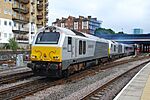 |
Diesel locomotive | 125 | 200 | 5 | N/A | Chiltern Main Line services | 1999–2000 | December 2014 |
| Class 121 |  |
DMU | 70 | 112 | 2 | 1 | Aylesbury–Princes Risborough | 1959–60 | 19 May 2017 |
| 172/1 |  |
100 | 160 | 4 | 2 | All Chiltern Railways services (apart from London-Amersham/Aylesbury line) | 2011 | May 2021 | |
Images for kids
-
A refurbished Class 165 DMU unit near South Hampstead
See also
 In Spanish: Chiltern Railways para niños
In Spanish: Chiltern Railways para niños




